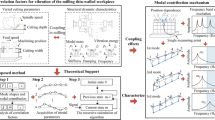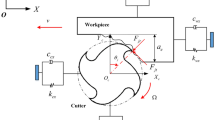Abstract
The distribution characteristics of machining errors in high energy efficiency milling are an important index to evaluate the surface geometry parameters, cutting stability, and dynamic cutting efficiency. The existing methods for machining errors focus on the overall level of the parameters of a machined surface and the degree of deviation from the index and ignore the influence of the instantaneous cutting behavior of a milling cutter and its teeth on the dynamic formation process of a machined surface. The dynamic distribution of machining errors in high energy efficiency milling needs to be revealed. According to the dynamic characteristics of the machined surface formation process with the effects of the cutter tooth error and milling vibration, a method for solving relative position vector of each point on the machined surface was proposed, and the calculation model of the dynamic distribution of the machining errors was constructed to unveil its formation mechanism in high energy efficiency milling. Using the time-frequency analysis method of the milling vibration and machining errors, the dynamic distribution of the machining errors on the machined surface was characterized, and the variety of the geometric error variation of the machined surface was described. The effects of the milling cutter design pose, cutting parameters, cutter tooth error, and milling vibration on the dynamic distribution of the machining errors were revealed, with the proposed identification method of its influencing factors. The response of the dynamic distribution of machining errors was studied, and a method for its identification was proposed and verified with experiments. The results showed that there was a high similarity between the calculated and measured results of the dynamic distribution of the machining errors. The influence mechanism of the key process variables on the dynamic distribution of the machining errors could be identified using the above model and method.




















Similar content being viewed by others
Availability of data and material
The datasets generated during and/or analyzed during the current study are available from the corresponding author on reasonable request.
References
Liu Y (2013) Localization design and manufacture of indexable high efficiency and high precision flat spiral end mill. Mech Eng 5:237–238
Yan B, Zhu L, Liu C (2020) Prediction model of peripheral milling surface geometry considering cutting force and vibration. Int J Adv Manuf Technol 110:5–6
Wang Z, Wang B, Yuan J (2018) Modeling of surface topography based on cutting vibration in ball-end milling of thin-walled parts. Int J Adv Manuf Technol 101:5–8
Chen Z, Lin PR, Zhou J, Saoubi RM, Gustafsson D, Moverare J (2019) Effect of machining parameters on cutting force and surface integrity when high-speed turning AD 730™ with PCBN tools. Int J Adv Manuf Technol 100:2601–2615
Wang Y, Lv CF (2019) Design and development of grinding vibration control system. Mach Tools Hydraul 047(013):85–87 93
Jin L, Chen YP, Ge DY (2020) Spatial statistical analysis of geometric deviation of free form surface. China Mech Eng 31(04):445–450
Mohammad L, Saeid A, Mohsen A (2018) Tool wear prediction and surface improvement in vibration cutting. Tribol Trans 61(3):414–423
Song XQ, Li QW, Gao W, Huang XZ (2019) Reliability sensitivity analysis of milling surface position error. Mech Des Manuf (09):86-88 + 92
Pham TH, Nguyen DT, Banh TL, Tong VC (2019) Experimental study on the chip morphology, tool–chip contact length, workpiece vibration, and surface roughness during high-speed face milling of A6061 aluminum alloy. Proc Inst Mech Eng Part B-J Eng Manuf 234(3):610–620
Xiong QC, Wang JX, Zhou QH (2018) Milling error prediction model based on machine tool accuracy and process parameters. Acta Aeronaut Sin 39(08):272–280
Rafan NA, Ab Rashid SNM, Jamaludin Z (2019) Assessment of friction behavior with surface location error analysis in milling process. Key Eng Mater 823:129–134
Zl A, Rs A, Ks A, Yi B, Dsm C (2019) Milutinovic. Sensitivity analysis of relationship between error motions and machined shape errors in five-axis machining center—peripheral milling using square-end mill as test case. Precis Eng 60:28–41
Sridhar R, Subramaniyan SP, Ramesh S (2019) Optimization of machining and geometrical parameters to reduce vibration while milling metal matrix composite. Trans Indian Inst Metals 72(12):3179–3189
Chun SH, Ko TJ (2011) Study on the response surface model of machining error in internal lathe boring. Int J Precis Eng Manuf 12(2):177–182
Balázs M, Bálint V, Wojciech Z (2019) The effect of the feed direction on the micro- and macro accuracy of 3D ball-end milling of chromium-molybdenum alloy steel. Materials 12(24):4038
Li ZY, Jiang SL, Sun YW (2019) Chatter stability and surface location error predictions in milling with mode coupling and process damping. Proc Inst Mech Eng Part B-J Eng Manuf 233(3):686–698
Zhang ML, Zhang DY, Geng DX, Shao ZY, Liu YH, Jiang XG (2020) Effects of tool vibration on surface integrity in rotary ultrasonic elliptical end milling of Ti6Al4V. J Alloys Compd 821:153266
Yu H, Qin S, Ding GF, Jiang L, Han L (2019) Integration of tool error identification and machining accuracy prediction into machining compensation in flank milling. Int J Adv Manuf Technol 102(7-8):3121–3134
Lim EM, Menq CH (1997) Error compensation for sculptured surface productions by the application of control-surface strategy using predicted machining errors. J Manuf Sci Eng 119(3):402–409
Huang T, Zhang XM, Ding H (2018) Error analysis of time-domain methods for milling stability prediction. Proc CIRP 77:457–460
Liu XB, Soshi M, Sahasrabudhe A, Yamazaki K (2006) A geometrical simulation system of ball end finish milling process and its application for the prediction of surface micro features. J Manuf Sci Eng 128(1):74–85
Dang JW, Zhang WH, Wan M, Yang Y, Wang YT (2011) A new prediction model of machining error in the process of milling. J Mech Eng 47(017):150–155
Zhang X, Zhang W, Zhang J, Pang B, Zhao W (2019) Systematic study of the prediction methods for machined surface topography and form error during milling process with flat-end cutter. Proc Inst Mech Eng Part B-J Eng Manuf 233(1):226–242
Wang DQ, Löser M, Luo YH, Ihlenfeldt S, Wang XB, Liu ZB (2020) Prediction of cumulative surface location error at the contact zone of in-process workpiece and milling tool. Int J Mech Sci 177(1):105543
Huang X, Zhang Y, Lv C (2016) Probabilistic analysis of dynamic stability for milling process. Nonlinear Dyn 86(3):1–10
Li ZL, Tuysuz O, Zhu LM, Altintas Y (2018) Surface form error prediction in five-axis flank milling of thin-walled parts. Int J Mach Tools Manuf 128:21–32
Funding
This work is supported by the National Nature Science Foundation of China (51875145).
Author information
Authors and Affiliations
Contributions
All authors contributed equally to this work.
Corresponding author
Ethics declarations
Ethics approval and consent to participate
This chapter does not contain any studies with human participants or animals performed by any of the authors.
Consent for publication
All authors consent to the publications of the manuscript in this journal.
Conflict of interest
The authors declare no competing interests.
Additional information
Publisher’s note
Springer Nature remains neutral with regard to jurisdictional claims in published maps and institutional affiliations.
Rights and permissions
About this article
Cite this article
Bin, J., Lili, F., Peiyi, Z. et al. Identification method for the dynamic distribution characteristics of machining errors in high energy efficiency milling. Int J Adv Manuf Technol 118, 255–274 (2022). https://doi.org/10.1007/s00170-021-07936-0
Received:
Accepted:
Published:
Issue Date:
DOI: https://doi.org/10.1007/s00170-021-07936-0




